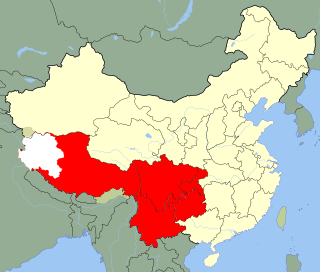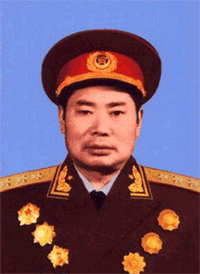
The People's Army of Vietnam, or the Vietnam People's Army (VPA), also informally recognized as the Vietnamese Army or the People's Army, is the military force of the Socialist Republic of Vietnam and the armed wing of the ruling Communist Party of Vietnam. The PAVN is a part of the Vietnam People's Armed Forces and includes: Ground Force, Navy, Air Force, Border Guard and Coast Guard. However, Vietnam does not have a separate Ground Force or Army branch. All ground troops, army corps, military districts and specialised arms belong to the Ministry of National Defence, directly under the command of the Central Military Commission, the Minister of Defence, and the General Staff of the Vietnam People's Army. The military flag of the PAVN is the flag of the Socialist Republic of Vietnam, with the words Quyết thắng added in yellow at the top left.

The Sino-Vietnamese War was a border war fought between China and Vietnam in early 1979. China launched an offensive in response to Vietnam's actions against the Khmer Rouge in 1978, which ended the rule of the Chinese-backed Khmer Rouge. Both China and Vietnam claimed victory in the last of the Indochina Wars.
Group armies, which are army-level military formations of the People's Liberation Army Ground Force of China.

The Chengdu Military Region was one of seven military districts and is located in the southwest of the People's Republic of China, covering Chongqing, Sichuan, Yunnan, Guizhou, and the Xizang/Tibet Autonomous Region. It includes some of the area previously within the Kunming Military Region and has its headquarters in Chengdu. It was probably established in 1955.

The Shenyang Military Region was one of seven military regions for the Chinese People's Liberation Army. It has command and control of military and armed police forces in the three northeast provinces of Jilin, Heilongjiang, and Liaoning, which also form Military Districts. This region is now superseded by the Northern Theater Command.

In the People's Republic of China, theater commands are joint commands responsible for developing strategy, plans, tactics, and policy specific to their assigned area of responsibility. Currently, the PRC subdivides the nation into five theater commands, Eastern, Southern, Western, Northern, and Central to provide the Central Military Commission (CMC) of the Chinese Communist Party (CCP) extensive, though not exclusive, command authority over the assigned region.

Yang Dezhi was a Chinese general and politician. He was senior military officer in the North China Field Army, a veteran of the Korean War and commander in China during the Sino–Vietnamese War.

Xu Shiyou was a general in the Chinese People's Liberation Army.
The campaign at the China–Burma border was a series of battles fought along the China–Burma border after the Chinese Civil War, with the communist People's Republic of China (PRC) and the Union of Burma on one side and the nationalist forces of the Republic of China (ROC) on the other. The government of the PRC refers to the campaign as the China–Burma border demarcation and security operation.

Qin Jiwei was a general of the People's Republic of China, Minister of National Defense and a member of the Chinese Communist Party Politburo.

Gennady Ivanovich Obaturov was a Soviet Army General.

Hoàng Văn Thái, born Hoàng Văn Xiêm, was a Vietnamese Army General and a communist political figure. His hometown was Tây An, Tiền Hải District, Thái Bình Province. During the Tết Offensive, he was the highest senior North Vietnamese officer in South Vietnam. He was the first chief of staff of the Vietnam People's Army, and was responsible for key military forces in North Vietnam. He was also Chief of Staff in the Battle of Điện Biên Phủ.

The Battle of Lào Cai was fought between Chinese and Vietnamese forces during the Sino-Vietnamese War. Though the Chinese sustained heavy losses in fighting, they were successful in capturing and occupying the city of Lào Cai and the surrounding towns.

Zhang Tingfa was a Chinese Communist revolutionary and a major general of the People's Liberation Army Air Force (PLAAF). He served as Political Commissar and Commander of the PLAAF, and was a member of the Central Military Commission (CMC). He also served two terms as a member of the Politburo of the Chinese Communist Party, before retiring in 1985. He fought in the Second Sino-Japanese War, the Chinese Civil War, and the Korean War, and commanded the Chinese Air Force during the Sino-Vietnamese War.
The Independent Division of Yunnan Provincial Military District (2nd Formation) was created on 5 May 1979 basing on the May Seventh Cadre School of Kunming Military Region as a result of Sino-Vietnamese War earlier that year.
The 11th Corps was a military formation of the Chinese People's Liberation Army. It was active from 1949 to 1952, with a six month break; and from 1969 to the end of 1985. It is currently inactive. In 1979 the corps took part in the Sino-Vietnamese War. In 1984 it again fought in Vietnam. It was stationed in the Kunming Military Region.
The 49th Infantry Division was a division of the Chinese People's Liberation Army. It was formed in March 1952 and in August designated as a light division of the national defense force. It was the second PRC infantry division numbered 49; the previous 49th Division had been disestablished in 1950-51.
Sun Ganqing was a major general of the Chinese People's Liberation Army. He served as chief of staff of the Guangzhou Military Region and the Kunming Military Region, and commander of the Hainan Military District. He was a veteran of the Second Sino-Japanese War, Chinese Civil War, and Sino-Vietnamese War.
Gu Hui was a general (shangjiang) of the People's Liberation Army (PLA). He was an alternate member of the 13th Central Committee of the Chinese Communist Party and a member of the 14th Central Committee of the Chinese Communist Party. He was a member of the Standing Committee of the 9th Chinese People's Political Consultative Conference.











